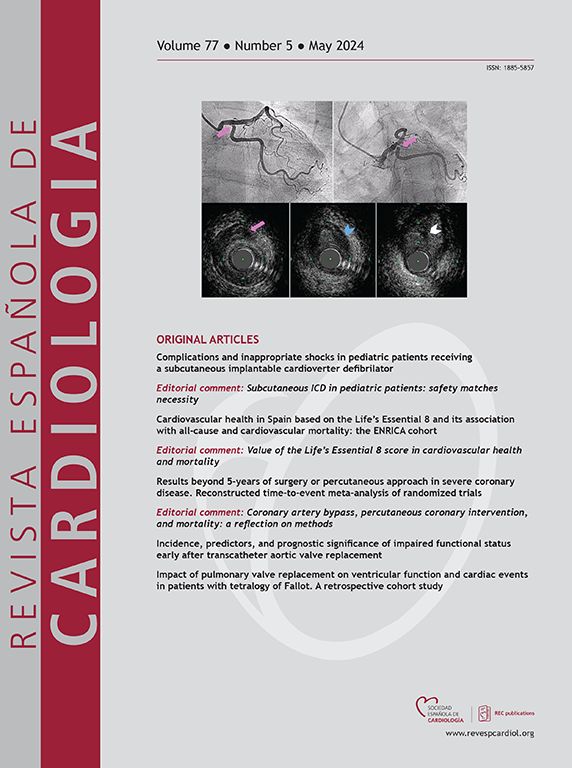第一代或新一代SLF植入左冠状动脉主干10年后的临床结果
IF 5.9
2区 医学
Q2 Medicine
引用次数: 0
摘要
前言与目的:左冠状动脉主干(LMCA)支架置入术后的长期数据很少,特别是新一代药物洗脱支架(DES)。本分析旨在描述不同DES代LMCA疾病患者经皮冠状动脉介入治疗的10年临床结果。方法收集随机对照ISAR-LEFT MAIN和ISAR-LEFT MAIN 2试验的个体患者资料,进行10年临床随访。使用Kaplan-Meier方法计算事件率。该分析的主要终点是全因死亡率、心肌梗死、靶病变血运重建和明确的支架血栓形成。结果共纳入1257例患者,其中新一代DES治疗650例,早期DES治疗607例,10年时两组患者死亡率均大于40%。经统计校正后,新一代DES患者的10年死亡率明显低于早期DES患者(HRadj, 0.78; 95%CI, 0.62-0.97)。10年后,新一代DES与早期DES相比,心肌梗死(HRadj, 0.43; 95%CI, 0.23-0.80)、靶区血管重建(HRadj, 0.66; 95%CI, 0.49-0.89)、明确支架血栓形成(HRadj, 0.13, 95%CI, 0.04-0.49)的风险均显著降低。结论无论DES代如何,接受经皮冠状动脉介入治疗LMCA疾病的患者10年死亡率均较高。与早期DES相比,新一代DES在LMCA患者中的使用与改善的长期临床结果相关。本文章由计算机程序翻译,如有差异,请以英文原文为准。
Resultados clínicos a 10 años tras el implante de SLF de primera o nueva generación en el tronco coronario izquierdo
Introduction and objectives
Long-term data after stenting of the left main coronary artery (LMCA) are scarce, especially regarding new-generation drug-eluting stents (DES). This analysis aimed to describe the 10-year clinical outcomes of patients who underwent percutaneous coronary intervention with different DES generations for LMCA disease.
Methods
Individual patient data from the randomized controlled ISAR-LEFT MAIN and ISAR-LEFT MAIN 2 trials were pooled and 10-year clinical follow-up was obtained. The Kaplan-Meier method was used to calculate event rates. The main endpoints of interest for this analysis were all-cause mortality, myocardial infarction, target lesion revascularization and definite stent thrombosis.
Results
A total of 1257 patients were included in this analysis, of which 650 patients were treated with new-generation DES and 607 with early-generation DES. At 10 years, the mortality rate was more than 40% in both groups. After statistical adjustment, 10-year mortality was significantly reduced in patients treated with new-generation DES compared with those treated with early-generation DES (HRadj, 0.78; 95%CI, 0.62-0.97). After 10 years, the risk of myocardial infarction (HRadj, 0.43; 95%CI, 0.23-0.80), target lesion revascularization (HRadj, 0.66; 95%CI, 0.49-0.89), and definite stent thrombosis (HRadj, 0.13, 95%CI, 0.04-0.49) was significantly reduced by new-generation DES compared with early-generation DES.
Conclusions
Patients undergoing percutaneous coronary intervention for LMCA disease have high 10-year mortality regardless of DES generation. The use of new-generation DES in patients with LMCA disease is associated with improved long-term clinical outcomes compared with early-generation DES.
求助全文
通过发布文献求助,成功后即可免费获取论文全文。
去求助
来源期刊

Revista espanola de cardiologia
医学-心血管系统
CiteScore
4.20
自引率
13.60%
发文量
257
审稿时长
28 days
期刊介绍:
Revista Española de Cardiología, Revista bilingüe científica internacional, dedicada a las enfermedades cardiovasculares, es la publicación oficial de la Sociedad Española de Cardiología.
 求助内容:
求助内容: 应助结果提醒方式:
应助结果提醒方式:


